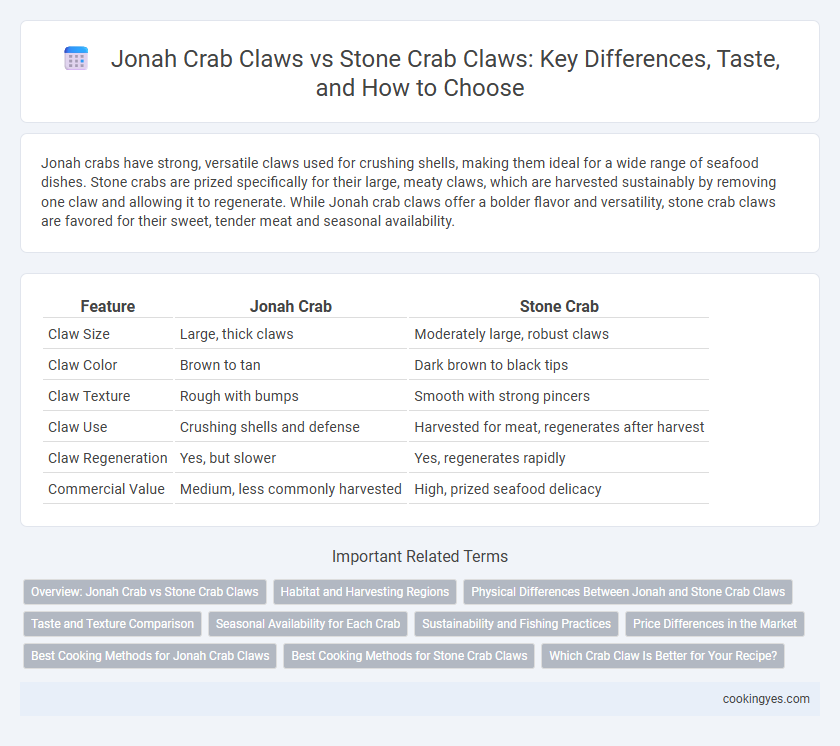Jonah crabs have strong, versatile claws used for crushing shells, making them ideal for a wide range of seafood dishes. Stone crabs are prized specifically for their large, meaty claws, which are harvested sustainably by removing one claw and allowing it to regenerate. While Jonah crab claws offer a bolder flavor and versatility, stone crab claws are favored for their sweet, tender meat and seasonal availability.
Table of Comparison
| Feature | Jonah Crab | Stone Crab |
|---|---|---|
| Claw Size | Large, thick claws | Moderately large, robust claws |
| Claw Color | Brown to tan | Dark brown to black tips |
| Claw Texture | Rough with bumps | Smooth with strong pincers |
| Claw Use | Crushing shells and defense | Harvested for meat, regenerates after harvest |
| Claw Regeneration | Yes, but slower | Yes, regenerates rapidly |
| Commercial Value | Medium, less commonly harvested | High, prized seafood delicacy |
Overview: Jonah Crab vs Stone Crab Claws
Jonah crab claws are larger and less sweet, offering a chewy texture ideal for hearty dishes, while stone crab claws are prized for their tender, sweet meat and unique ability to autotomize, making them sustainable with annual harvests of new claw growth. Stone crab claws are typically smaller but considered a delicacy in Florida, especially during their official harvesting season from October to May. Jonah crab claws are more commonly found along the northeastern U.S. coast and are often used in gourmet recipes for their robust flavor.
Habitat and Harvesting Regions
Jonah crabs primarily inhabit the rocky coastal waters of the North Atlantic, particularly from Nova Scotia to North Carolina, thriving in cooler, shallower habitats. Stone crabs are found mainly in the warm, shallow waters of the western North Atlantic, especially along the coasts of Florida and the Gulf of Mexico, favoring sandy or muddy bottoms. Harvesting of Jonah crab claws typically occurs in New England waters, while stone crab claws are predominantly harvested in Florida with regulated trap systems to ensure sustainability.
Physical Differences Between Jonah and Stone Crab Claws
Jonah crab claws are generally larger and more robust, with a rough, textured surface and a dark purplish-brown color, whereas stone crab claws are smoother, heavier relative to size, and display a distinct black tip contrasting with a lighter, yellowish base. The stone crab claw's immovable, hammer-like crusher claw is more symmetrical and powerful for breaking shells compared to the asymmetrical claws of the Jonah crab. These physical differences reflect their varying feeding habits and habitat adaptations, with stone crabs evolved for crushing hard shells and Jonah crabs for a broader diet including softer prey.
Taste and Texture Comparison
Stone crab claws offer a sweet, rich flavor with a firm and slightly crunchy texture, prized for their succulent meat and clean oceanic taste. Jonah crab claws deliver a meatier, denser bite with a subtle sweetness and a creamier, softer texture compared to stone crabs. The choice between the two often hinges on preference for either the stone crab's crisp firmness or the Jonah crab's tender richness.
Seasonal Availability for Each Crab
Jonah crab claws are primarily available from late spring through early fall, peaking between May and October, aligning with their seasonal molting cycles. Stone crab claws, on the other hand, are harvested mainly from October through May, with peak availability in the winter months, as fishermen harvest only one claw per crab, allowing regeneration. Understanding these seasonal patterns is crucial for optimizing fresh crab claw supply and culinary use.
Sustainability and Fishing Practices
Stone crab claws are favored for their sustainable harvesting methods, where only one claw is taken, allowing the crab to regenerate it and continue thriving in the ecosystem. Jonah crab, while also commercially fished, often experiences less stringent regulations, leading to concerns about population impact and fishing pressure. Sustainable practices in stone crab fisheries include regulated trap limits and seasonal closures that help maintain healthy populations and long-term availability.
Price Differences in the Market
Stone crab claws generally command a higher market price than Jonah crab claws due to their superior sweetness and larger size. Jonah crab claws tend to be more affordable, making them a budget-friendly option for seafood enthusiasts. Price variations also depend on regional availability, with stone crab claws fetching premium rates in Florida's seasonal markets.
Best Cooking Methods for Jonah Crab Claws
Jonah crab claws are prized for their sweet, tender meat and are best cooked by steaming or boiling for about 5-7 minutes to preserve their delicate flavor and texture. Unlike stone crab claws, which are typically harvested for their tough, chewy shells and require cracking, Jonah crab claws benefit from gentle cooking methods like sauteing or baking with garlic butter to enhance their natural sweetness. Steaming or boiling Jonah crab claws maintains moisture, making them ideal for dipping in drawn butter or incorporating into seafood pasta dishes.
Best Cooking Methods for Stone Crab Claws
Stone crab claws are prized for their sweet, tender meat, best preserved through steaming or boiling to maintain their natural flavor and moisture. Baking stone crab claws with a light seasoning can enhance their taste without overpowering the delicate texture. Serving chilled with mustard sauce highlights their freshness, making these methods optimal for preparing stone crab claws compared to Jonah crab claws, which require longer cooking times due to their denser meat.
Which Crab Claw Is Better for Your Recipe?
Stone crab claws are prized for their sweet, succulent meat and thick, firm texture, making them ideal for dishes that highlight rich, buttery flavors like crab salads or crab dips. Jonah crab claws, while less sweet, offer a slightly brinier taste and a tender yet robust meat consistency, perfect for recipes requiring a more pronounced seafood flavor such as seafood stews or pasta. Choosing between Stone and Jonah crab claws depends on whether your recipe benefits from a delicate sweetness or a stronger, savory crab essence.
Jonah vs Stone Crab for claws Infographic

 cookingyes.com
cookingyes.com